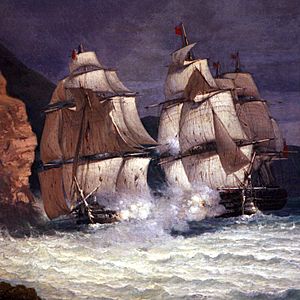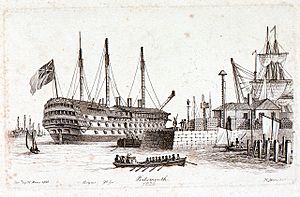HMS Boyne (1810) facts for kids

Fight of the Romulus against HMS Boyne and HMS Caledonia, by Vincent Courdouan (1848)
|
|
Quick facts for kids History |
|
|---|---|
| Name | HMS Boyne |
| Ordered | 25 June 1801 |
| Builder | Portsmouth Dockyard |
| Laid down | April 1806 |
| Launched | 3 July 1810 |
| Renamed | HMS Excellent, 1834 |
| Fate | Broken up, 1861 |
| General characteristics | |
| Class and type | Boyne-class ship of the line |
| Tons burthen | 2155 bm |
| Length | 186 ft (57 m) (gundeck) |
| Beam | 51 ft 5 in (15.67 m) |
| Depth of hold | 22 ft (6.7 m) |
| Propulsion | Sails |
| Sail plan | Full-rigged ship |
| Complement | 738 (650 razeed) |
| Armament |
|
HMS Boyne was a large warship built for the Royal Navy in the early 1800s. She was known as a "ship of the line," which meant she was a powerful sailing ship designed to fight in a battle line. These ships were the main warships of their time.
Boyne was built at Portsmouth Dockyard in England. She was launched on July 3, 1810. When first built, she carried 98 guns. This made her a "second-rate" ship, meaning she was one of the larger and more powerful ships in the fleet.
Early Life and Battles
In 1814, HMS Boyne took part in an important battle. On February 12, she fought alongside another British ship, HMS Caledonia. They faced a French warship called Romulus near Toulon, France.
The battle was intense, but the French ship managed to escape. Romulus sailed very close to the coast. This helped her avoid being surrounded by the British ships.
After this, the way ships were classified changed. In 1817, Boyne was re-rated as a "first-rate" ship. This meant she was now considered a 104-gun ship, placing her in the highest class of warships.
Changes and New Roles
Life at sea could be tough for these big ships. On November 23, 1824, a strong storm hit Portsmouth. HMS Boyne was driven ashore during this gale. Luckily, she was not completely destroyed.
A few years later, in 1826, Boyne went through a big change. She was "razeed." This means some of her upper decks were removed. This made her a two-deck ship with 76 guns. She was now a "third-rate" ship. Razeeing a ship could make it lighter and sometimes faster.
On December 1, 1834, Boyne got a new name: HMS Excellent. She also got a new job. Instead of fighting, she became a training ship. She helped teach new sailors and officers how to operate a warship.
End of an Era
HMS Excellent continued her role as a training ship for many years. In 1859, she was renamed again to HMS Queen Charlotte. She was taken out of service, or "paid off," the next month.
Finally, from December 1861, the old warship was broken up. This marked the end of a long and varied career for HMS Boyne, which served the Royal Navy for over 50 years.


